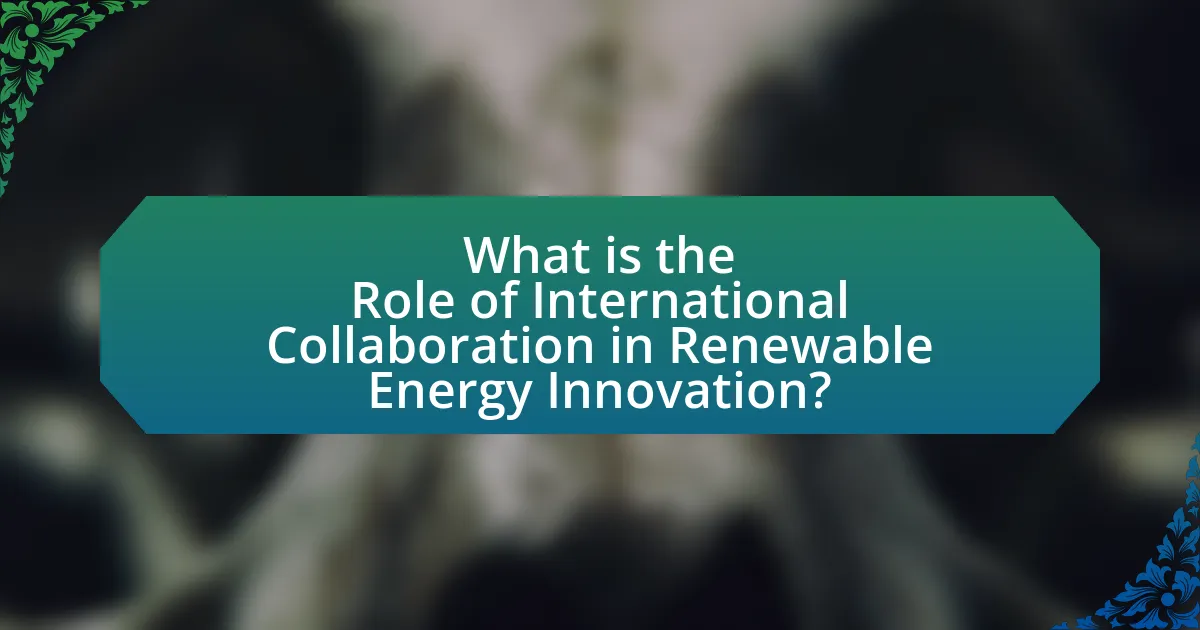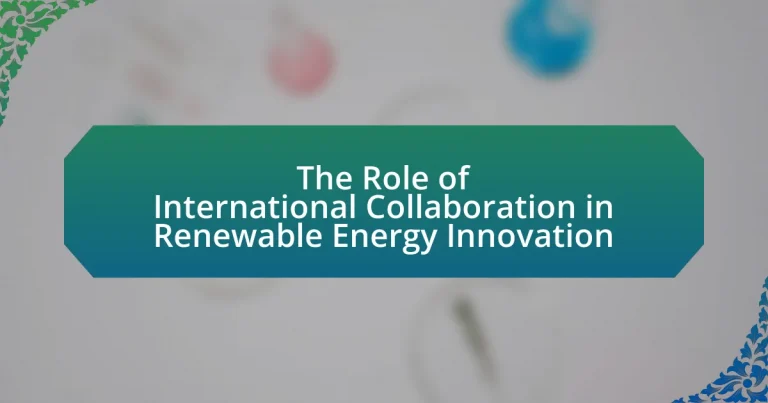The article examines the critical role of international collaboration in driving innovation within the renewable energy sector. It highlights how partnerships among countries facilitate knowledge sharing, resource pooling, and joint research initiatives, leading to technological advancements and cost reductions. Key components for successful collaboration, such as clear communication and mutual trust, are discussed alongside the contributions of various nations to renewable energy innovation. The article also addresses the challenges faced without collaboration and outlines best practices and future trends that can enhance cooperative efforts in renewable energy development.

What is the Role of International Collaboration in Renewable Energy Innovation?
International collaboration plays a crucial role in renewable energy innovation by facilitating knowledge sharing, resource pooling, and joint research initiatives among countries. This collaboration accelerates technological advancements and reduces costs through shared expertise and funding. For instance, the International Renewable Energy Agency (IRENA) reported that collaborative efforts in research and development can lead to a 30% reduction in the cost of renewable technologies by 2030. Additionally, partnerships such as the Clean Energy Ministerial bring together governments and stakeholders to promote policies and share best practices, further enhancing innovation in the sector.
How does international collaboration enhance renewable energy innovation?
International collaboration enhances renewable energy innovation by facilitating the sharing of knowledge, resources, and technologies across borders. This collaborative approach allows countries to leverage diverse expertise and experiences, leading to accelerated advancements in renewable energy solutions. For instance, the International Renewable Energy Agency (IRENA) reports that collaborative projects can reduce costs and improve efficiency by pooling investments and research efforts, exemplified by initiatives like the Global Solar Alliance, which aims to promote solar energy deployment worldwide. Such partnerships not only foster innovation but also help in addressing global challenges like climate change by creating scalable and sustainable energy solutions.
What are the key components of successful international collaboration?
The key components of successful international collaboration include clear communication, mutual trust, shared goals, and cultural sensitivity. Clear communication ensures that all parties understand expectations and responsibilities, which is crucial in diverse teams. Mutual trust fosters a collaborative environment where participants feel valued and are more likely to share ideas and resources. Shared goals align the efforts of different stakeholders, driving collective action towards common objectives. Cultural sensitivity acknowledges and respects the diverse backgrounds of collaborators, enhancing cooperation and reducing misunderstandings. These components are supported by studies indicating that effective communication and trust significantly improve project outcomes in international partnerships, particularly in sectors like renewable energy innovation.
How do different countries contribute to renewable energy innovation?
Different countries contribute to renewable energy innovation through investments in research and development, policy frameworks, and international collaborations. For instance, Germany leads in solar energy technology due to its Feed-in Tariff policy, which incentivizes solar power adoption, resulting in over 50 gigawatts of installed capacity by 2020. The United States invests heavily in wind energy, with Texas generating more than 30% of its electricity from wind as of 2021, showcasing the effectiveness of state-level renewable energy mandates. China plays a crucial role by being the largest manufacturer of solar panels, producing over 70% of the world’s supply, which drives down costs globally. These contributions highlight how diverse approaches and resources from different nations foster innovation in renewable energy technologies.
Why is international collaboration essential for renewable energy advancements?
International collaboration is essential for renewable energy advancements because it enables the sharing of knowledge, technology, and resources across borders. This collaboration accelerates innovation by combining diverse expertise and experiences, leading to more effective solutions for global energy challenges. For instance, the International Renewable Energy Agency (IRENA) reports that collaborative efforts can reduce costs and improve the efficiency of renewable technologies, as seen in joint research initiatives and shared projects among countries. Such partnerships also facilitate the development of global standards and policies that promote sustainable energy practices, further driving advancements in the sector.
What challenges do countries face in renewable energy innovation without collaboration?
Countries face significant challenges in renewable energy innovation without collaboration, including limited access to technology, insufficient funding, and fragmented research efforts. Without collaboration, nations struggle to share best practices and innovations, which can hinder the development of efficient renewable energy solutions. For instance, a report by the International Renewable Energy Agency (IRENA) highlights that countries lacking collaborative frameworks often miss out on economies of scale and the pooling of resources necessary for large-scale renewable projects. Additionally, isolated efforts can lead to duplicated research and wasted resources, as seen in various national initiatives that fail to leverage global advancements in solar and wind technologies.
How does collaboration lead to shared knowledge and resources?
Collaboration leads to shared knowledge and resources by facilitating the exchange of expertise and information among diverse stakeholders. When organizations, researchers, and governments work together, they pool their unique insights and capabilities, resulting in a comprehensive understanding of challenges and solutions in renewable energy. For instance, the International Renewable Energy Agency (IRENA) reports that collaborative projects often yield innovative technologies and practices that individual entities may not achieve alone, enhancing overall efficiency and effectiveness in energy solutions. This synergy not only accelerates the development of renewable technologies but also optimizes resource allocation, as partners can share funding, infrastructure, and human capital, thereby maximizing the impact of their collective efforts.
What are the outcomes of effective international collaboration in renewable energy?
Effective international collaboration in renewable energy leads to accelerated technological advancements, increased investment, and enhanced policy frameworks. Collaborative efforts, such as the International Renewable Energy Agency (IRENA), have facilitated knowledge sharing and innovation, resulting in a 20% reduction in the cost of solar energy technologies from 2010 to 2020. Furthermore, partnerships among countries have mobilized over $300 billion in investments for renewable projects globally, demonstrating the financial benefits of collaboration. Additionally, joint initiatives have established comprehensive policy guidelines that promote sustainable energy practices, contributing to a 45% increase in global renewable energy capacity from 2010 to 2020.
How do collaborative projects impact technological advancements?
Collaborative projects significantly accelerate technological advancements by pooling resources, expertise, and diverse perspectives. For instance, international collaborations in renewable energy, such as the International Solar Alliance, have led to innovations in solar technology, resulting in a 90% reduction in the cost of solar photovoltaic systems since 2009. This collective effort not only enhances research and development but also facilitates the sharing of best practices and technologies across borders, driving faster implementation and scaling of new solutions.
What role do international agreements play in fostering innovation?
International agreements play a crucial role in fostering innovation by establishing frameworks for collaboration, standardization, and resource sharing among countries. These agreements facilitate the exchange of knowledge and technology, which accelerates the development of innovative solutions, particularly in sectors like renewable energy. For instance, the Paris Agreement encourages nations to commit to reducing greenhouse gas emissions, prompting collaborative research and investment in clean technologies. Such cooperative efforts have led to advancements in solar and wind energy technologies, as evidenced by the International Renewable Energy Agency’s report, which highlights that global renewable energy capacity has increased significantly due to international partnerships and agreements.
How can countries improve their collaborative efforts in renewable energy?
Countries can improve their collaborative efforts in renewable energy by establishing international agreements that promote technology sharing and joint research initiatives. For instance, the Paris Agreement encourages nations to work together on climate change solutions, which includes renewable energy advancements. Collaborative platforms like the International Renewable Energy Agency (IRENA) facilitate knowledge exchange and best practices among member countries, enhancing innovation and efficiency in renewable technologies. Furthermore, funding joint projects through multilateral development banks can accelerate the deployment of renewable energy solutions globally, as evidenced by the Green Climate Fund, which supports projects in developing nations.
What are the best practices for fostering international collaboration in renewable energy innovation?
The best practices for fostering international collaboration in renewable energy innovation include establishing clear communication channels, creating joint research initiatives, and aligning regulatory frameworks across countries. Clear communication channels facilitate the exchange of ideas and best practices, which is essential for innovation. Joint research initiatives, such as the International Energy Agency’s collaborative projects, enable countries to pool resources and expertise, leading to more effective solutions. Aligning regulatory frameworks helps to reduce barriers to collaboration, as seen in the European Union’s efforts to harmonize renewable energy policies among member states. These practices enhance cooperation and accelerate advancements in renewable energy technologies.
How can countries leverage existing networks for better collaboration?
Countries can leverage existing networks for better collaboration by actively participating in international organizations and partnerships focused on renewable energy. For instance, initiatives like the International Renewable Energy Agency (IRENA) facilitate knowledge sharing and resource pooling among member countries, enhancing collaborative efforts. Additionally, countries can utilize platforms such as the Clean Energy Ministerial, which brings together governments and stakeholders to promote policies and share best practices in clean energy. These networks provide access to technical expertise, funding opportunities, and innovative technologies, thereby strengthening collaborative frameworks and accelerating renewable energy innovation.
What strategies can be implemented to overcome barriers to collaboration?
To overcome barriers to collaboration in renewable energy innovation, organizations can implement strategies such as establishing clear communication channels, fostering trust through relationship-building, and creating shared goals. Clear communication channels ensure that all stakeholders understand their roles and responsibilities, which reduces misunderstandings and enhances cooperation. Trust can be built through regular interactions and transparency in decision-making, which encourages open dialogue and collaboration. Additionally, creating shared goals aligns the interests of diverse stakeholders, motivating them to work together towards common objectives. Research indicates that organizations that prioritize these strategies experience improved collaboration outcomes, as evidenced by successful international partnerships in renewable energy projects.
What future trends can we expect in international collaboration for renewable energy innovation?
Future trends in international collaboration for renewable energy innovation will increasingly focus on joint research initiatives, technology sharing, and cross-border investments. Collaborative platforms such as Mission Innovation, which includes 24 countries and the European Union, aim to accelerate public and private clean energy innovation through shared goals and funding commitments. Additionally, the rise of global partnerships, like the International Solar Alliance, emphasizes the importance of collective action in scaling renewable technologies. These trends are supported by the growing recognition that climate change is a global challenge requiring coordinated efforts, as evidenced by the Paris Agreement, which encourages nations to work together to meet emission reduction targets.
How will emerging technologies influence international collaboration?
Emerging technologies will significantly enhance international collaboration by facilitating real-time communication, data sharing, and joint research initiatives. For instance, advancements in artificial intelligence and blockchain enable secure and efficient collaboration across borders, allowing countries to pool resources and expertise in renewable energy projects. A report by the International Renewable Energy Agency (IRENA) highlights that digital technologies can reduce costs and improve the efficiency of renewable energy systems, thereby fostering partnerships among nations. Furthermore, platforms for collaborative innovation, such as the Clean Energy Ministerial, leverage these technologies to accelerate the deployment of renewable energy solutions globally.
What role will policy changes play in shaping future collaborations?
Policy changes will significantly influence future collaborations in renewable energy innovation by establishing regulatory frameworks that encourage joint ventures and partnerships. These frameworks can create incentives for countries and organizations to collaborate on research and development, share technology, and pool resources. For instance, the Paris Agreement has prompted nations to align their policies with climate goals, fostering international cooperation in renewable energy projects. Such policy shifts can lead to increased funding opportunities and collaborative platforms, ultimately driving innovation and accelerating the transition to sustainable energy solutions.
What practical steps can nations take to enhance international collaboration in renewable energy?
Nations can enhance international collaboration in renewable energy by establishing joint research initiatives and funding programs that focus on shared technological advancements. Collaborative projects, such as the International Solar Alliance, demonstrate how countries can pool resources and expertise to accelerate the development and deployment of renewable technologies. Furthermore, nations can create bilateral and multilateral agreements that facilitate knowledge exchange, standardize regulations, and promote investment in renewable energy infrastructure. For instance, the Clean Energy Ministerial brings together governments to share best practices and drive global clean energy transitions, showcasing the effectiveness of cooperative frameworks.




